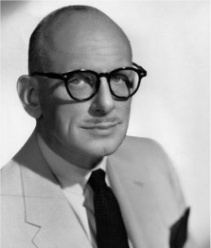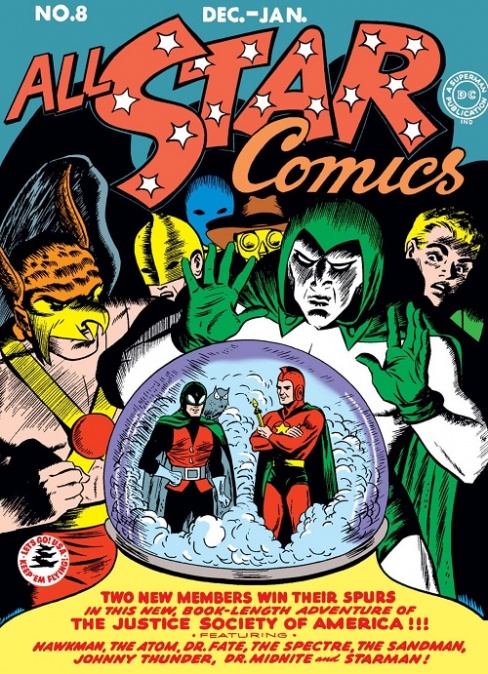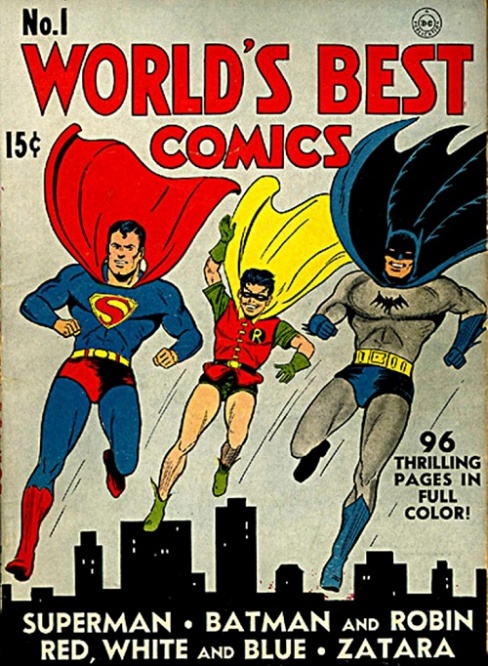Multiversity’s history column turns the clock back to 1941 for a two-part look at the state of the industry. Last week, we looked at raw numbers, content trends, and public opinion. Now it’s time for a closer look at what was going on at specific publishers.

In 1941, communism was not yet the dirty word it would become following the end of World War II, and it was something seriously considered by many American’s when capitalism lost its luster during the Great Depression. One particular individual who thought the communist ideals had some merit was publisher Lev Gleason. True to those beliefs, he shared profits from successful books with their creators and he encouraged his editors, Charles Biro and Bob Wood, to put their names on the covers of their comics.
When Gleason published “Daredevil” #2 in mid 1941, it was notable for two reasons. First, it included a story by Jerry Robinson (co-creator of the Joker) about a character named London. While that probably doesn’t mean anything to you as the character didn’t become popular, it was the first time Robinson was allowed to sign his printed work with his own name. Also in “Daredevil” #2, Gleason’s commitment to fairness for all led to the feature ‘Real American’, a strip starring the first Native American superhero.
Another 1941 event was significant to Gleason’s publishing line but the impact wouldn’t be felt until the following year. Well, the event probably happened. Mostly. Somehow.

Biro, one of Gleason’s aforementioned editors, told people he’d been in a bar when a fellow patron offered to let him sleep with a beautiful woman he had upstairs if Biro would let the man watch. Biro declined, but the offer was memorable. Within a few days, he learned through a newspaper story that the man was arrested because he had abducted the woman and the adventurous, consensual, bondage sex he’d been offering at bars was actually rape. Shocked by how close of a connection he had to such an awful crime, Biro was inspired to start the true crime comic series “Crime Does Not Pay” with Wood. Lead time to produce the material prevented its release until 1942.
Here’s the catch about the story – Biro did not share it widely until the 50s, and his narrative sometimes included more specific details, like the villain being the heir to a margarine fortune. However, said heir wasn’t arrested until 1952. Was Biro’s story embellished, or completely fabricated? I tend to lean toward the former only because it’s plausible, but I wouldn’t argue with anyone who leaned toward the latter. It’s not like true crime was a wholly original idea – it had been a popular genre in novels and pulp magazines for at least twenty years before Biro brought it to comics.

When it comes to Marvel Comics (then known as Timely) in 1941, the big news was all about superheroes. The company’s two original heroes, Namor and Human Torch, were each appearing in six different titles to meet demand. Demand, and because publisher Martin Goodman believed a trend should be milked as fast and as thoroughly as possible. Timely’s newest hero, Captain America, debuted with a March 1941 cover date, but this column has already covered that in detail here.
During that first year of “Captain America Comics”, Timely saw other milestones. The name “Stan Lee” debuted in the third issue on a two-page text piece titled “Captain America Foils the Traitor’s Revenge”. This supplemental story that was included because the post office offered a lower rate on periodicals with a minimum of two pages of prose, based on the theory that catalogs wouldn’t have them and should pay more. Stanley Lieber was young at the time and wanted to be a real writer when he got older, so he chose the pen name. When Joe Simon asked if it was his first name cut in half or a shortened version of both names, Lieber said Simon should choose the answer.
Rival publisher MLJ quickly noticed the similarities between Captain American and their own patriotic hero The Shield, and they threatened a lawsuit until Timely capitulated by changing the shape of Cap’s shield. A few months later, MLJ got rankled again when Cap fought the evil Hangman in issue 6. When MLJ pointed out they had a hero named the Hangman, Marvel was able to avoid a lawsuit again by promising not to use the character again.
Continued belowCaptain America’s creators Joe Simon and Jack Kirby were unhappy with their pay on the character and were fired by Goodman when they were working on the tenth issue. By then, they were recognized as industry successes and were quickly snatched up by Jack Lieobowitz, the publisher of DC (then known as National). To secure the wunderkinds, Liebowitz doubled their pay and guaranteed a minimum amount of work. Goodman later claimed the duo had exaggerated how badly the had cheated them to get a better deal from DC, as though “I didn’t rip them off that bad” was a good defense.

As mentioned last week, DC instituted an advisory board in 1941 to give their comics an added aura of decency. One of the board members was William Moulton Marston, a Harvard-educated psychologist interested in the educational uses of comics. Unlike other board members, he took an active role at DC and campaigned for a woman superhero. Max Gaines, who was running the company’s All American wing, agreed to try it. After some tinkering, Wonder Woman debuted as a backup feature in “All Star Comics” #8 in late 1941 and returned in January 1942 as the lead feature of “Sensation Comics” #1.
Meanwhile, “Action Comics” remained the company’s top seller with sales at 900,000 copies a month and climbing. Between that and the “Superman” title, the character grossed DC over $950,000 in 1941. Creators Jerry Siegel and Joe Shuster were sharing that haul to the tune of $150,000 per year. Beyond comics, Superman was also appearing on the radio and in the comic section of 230 newspapers. To take advantage of this success, DC launched the anthology “World’s Best Comics” that combined Batman and Superman under one cover but in solo adventures. The new comic was as close to “prestige” format as you could get in 1941: it was 96 pages with thick cardboard covers for the hefty price of fifteen cents.

Alas, Superman was not the most popular superhero – Captain Marvel was. Feeling this was unjust, DC filed suit against Fawcett in 1941 claiming Captain Marvel was so similar to Superman that it violated copyright laws. This weak claim was initially dismissed, but DC appealed and the court arguments lasted for 12 years. It would have been longer, but sales dropped in 1953 and Fawcett decided it was cheaper to quit publishing.
Because Superman was so popular, it was only natural that Hollywood would want in on the action. Republic Studios had the rights to make a live action serial, but DC was too protective of their property and put restriction after restriction on Republic until they dropped the project in 1941. Not wanting to completely abandon the concept, and perhaps with a little spite, Republic partnered with Fawcett that same year to create Adventures of Captain Marvel, which was the first live action comic superhero. DC tried to block the release legally, but failed.

Film rights for Superman moved on to Paramount Studios instead, who chose to pursue it in animation. They turned to Fleischer Bros, who initially agreed but then wanted out of the deal. To avoid breaking the contract, they told Paramount each episode would need a budget of $100,000, four times the standard. When Paramount countered at $50,000 per episode, the brothers decided to keep the job. In return, Paramount received nine animated shorts with such high quality that they’re still well-regarded 80 years later. The first was released to theaters September 26, 1941, and was nominated for an Oscar.






